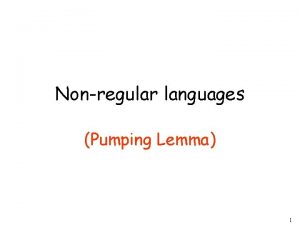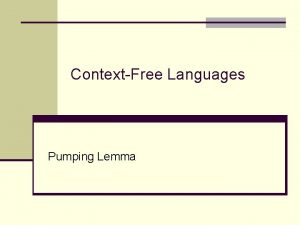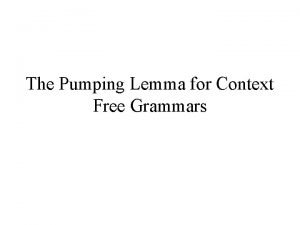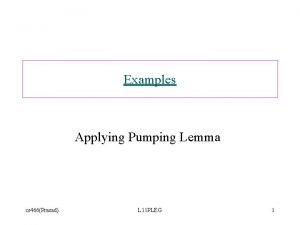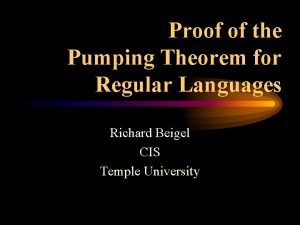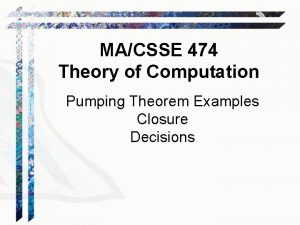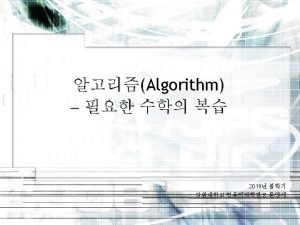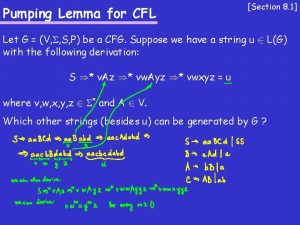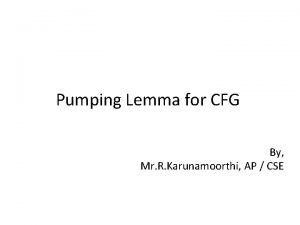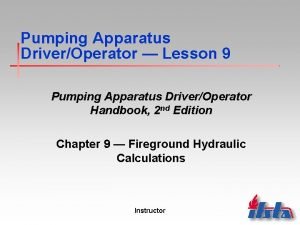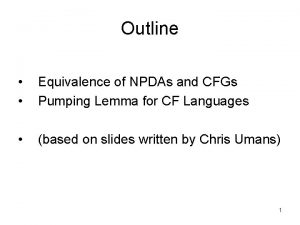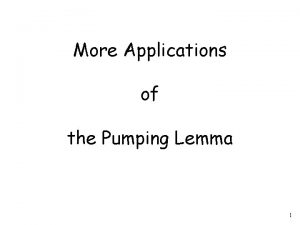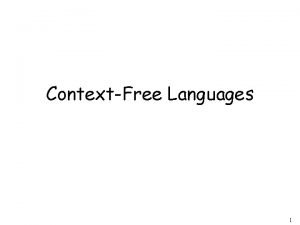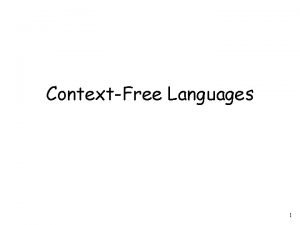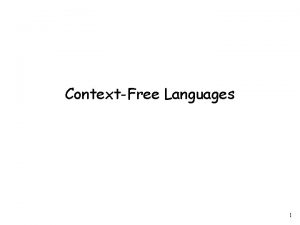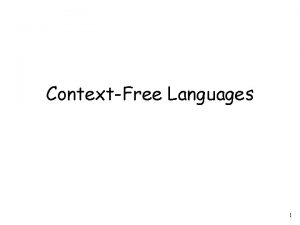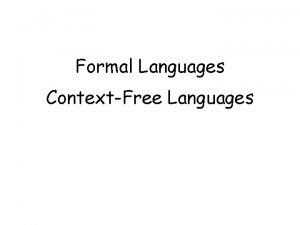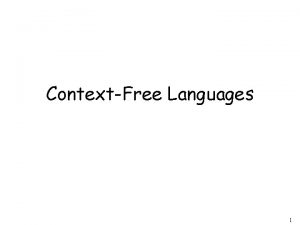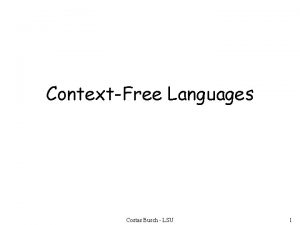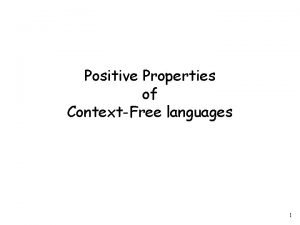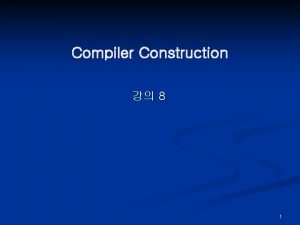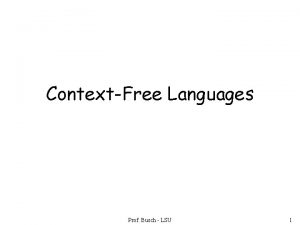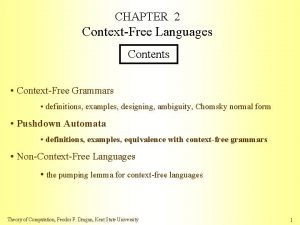Use the pumping theorem for contextfree languages to














- Slides: 14

Use the pumping theorem for context-free languages to prove that L= { an b ap : n, p ≥ 0 , p ≥ n } is not context-free. Hint: For the pumping theorem, factor in all ways as u v x y z such that |v| +|y| ≥ 1 and for each case, argue that u vn x yn z is not in L for some n. 1

The Pumping Theorem for Context-Free Languages: Let G be a context-free grammar. Then there exists some constant k which depends on G such that for any string w which is generated by G with |w| ≥ k, there exists u, v, x, y, z, such that 1. w= u v x y z, 2. |v| + |y| ≥ 1, and 3. u vn x yn z is in L for all n ≥ 0. 2

Assignment #4 has been posted, due on Friday Nov. 18, beginning of class. No tutorials this week. You can go and ask questions next week if you need help, but you are not expected to attend. Some old final exams are posted. Our final is very early in the exam schedule - keep up? 3

Closure Properties: We have constructions that use the context-free grammars proving that contex-free languages are closed under union, concatenation and Kleene star. We have a construction that uses a PDA and a DFA that proves that context-free languages are closed under intersection with regular languages. 4

Intersection: L 1 = { an bn cp : n, p ≥ 0} L 2 = { an bp cn : n, p ≥ 0} What is L 1 ∩ L 2? 5

Exclusive OR: L 1 = a* b* c* L 2 = { ap bq cr : p≠ q or p ≠ r or q≠r } What is L 1 Å L 2? 6

Difference: L 1 = a* b* c* L 2 = { ap bq cr : p≠ q or p ≠ r or q≠r } What is L 1 - L 2? 7

L = { an bn cn : n ≥ 0} L 1 = { a p bq c r : p ≠ q } L 2 = { a p bq c r : p ≠ r } L 3 = { a p bq c r : q ≠ r } The complement of L is NOT equal to L 1 ⋃ L 2 ⋃ L 3. Which strings are in the complement of L but not in L 1 ⋃ L 2 ⋃ L 3? 8

L = { an bn cn : n ≥ 0} L 1 = { a p bq c r : p ≠ q } L 2 = { a p bq c r : p ≠ r } L 3 = { a p bq c r : q ≠ r } L 4 = { w {a, b, c}* : w ∉ a* b* c*} L 1 ⋃ L 2 ⋃ L 3⋃ L 4 is context-free and is the complement of L. Therefore, context-free languages are not 9 closed under complement.

Theorem: L= { ap : p is a prime number} is not context-free. Theorem: L= { an 2 : n ≥ 0} is not context-free. Note: if L is a language defined over a one symbol alphabet and you can prove L is not regular using the pumping lemma, then it also means that L is not context-free. 10

Theorem: L= { ap : p is a prime number} is not context-free. Assume L is context-free and is generated by a context-free grammar G. Then there exists some constant k dependent on G such that for all strings w in L of length at least k the Pumping Theorem holds. Choose w= ap for some prime number p ≥ k. 11

Factor ap in all ways as u v x y z: w = ai aj ar as at where p= i + j + r + s + t, j + s ≥ 1, v=aj and y= as. Pumping n+1 times yields: ai (aj )n+1 ar (as)n+1 at = ai ar at (aj )n+1 (as)n+1 = ap-j-s + (j+s)(n+1) Let x= j+s. Pumping n+1 times yields: ap+xn 12

w = a i aj a r as at Let x= j+s. Pumping n+1 times yields: ap+xn Pump p+1 times: Gives ap+xp = ap(x+1) Since x 1, (x+1) 2 and so p (x+1) Cannot be prime. 13

Theorem: L= { an 2 : n ≥ 0} is not context-free. Note: if L is a language defined over a one symbol alphabet and you can prove L is not regular using the pumping lemma, then it also means that L is not context-free. 14
 Pumping lemma non regular languages examples
Pumping lemma non regular languages examples Pumping lemma for cfls
Pumping lemma for cfls Context free grammar pumping lemma
Context free grammar pumping lemma Cs
Cs Pumping theorem
Pumping theorem Pumping theorem
Pumping theorem Stokes theorem gives relationship between
Stokes theorem gives relationship between Why do languages vary among places
Why do languages vary among places 펌핑 보조정리
펌핑 보조정리 Pumping lemma for cfl examples
Pumping lemma for cfl examples Pumping lemma for cfg examples
Pumping lemma for cfg examples Condensed q formula for 4 inch
Condensed q formula for 4 inch Pumping lemma 예제
Pumping lemma 예제 Applications of pumping lemma
Applications of pumping lemma High pumping speed large ion pump
High pumping speed large ion pump
